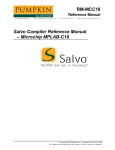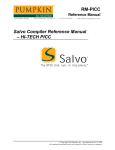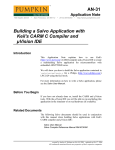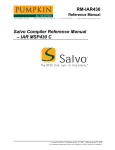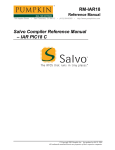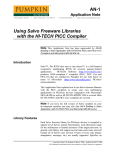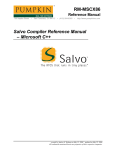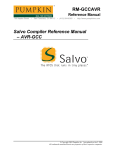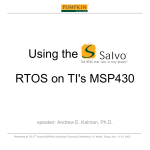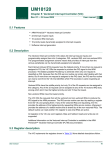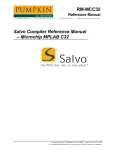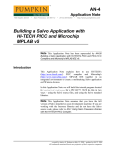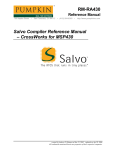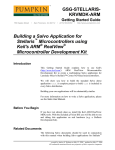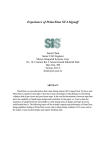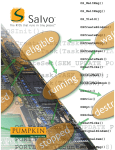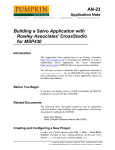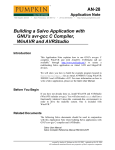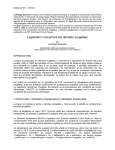Download RM-KCARM Salvo Compiler Reference Manual
Transcript
RM-KCARM
Reference Manual
750 Naples Street
•
San Francisco, CA 94112
• (415) 584-6360
•
http://www.pumpkininc.com
Salvo Compiler Reference Manual
– Keil CARM
© Copyright 2004 Pumpkin, Inc. last updated on Oct 17, 2004
All trademarks mentioned herein are properties of their respective companies.
Reference Manual
Introduction
This manual is intended for Salvo users who are targeting
ARM7TDMI MCUs with Keil's (http://www.keil.com/) CARM C
compiler.
Related Documents
The following Salvo documents should be used in conjunction
with this manual when building Salvo applications with Keil's
CARM C compiler:
Salvo User Manual
Application Note AN-31
Example Projects
Example Salvo projects for use with Keil's CARM C compiler and
Keil's µVision3 IDE can be found in the:
\salvo\ex\ex1\sysag
\salvo\tut\tu1\sysag
\salvo\tut\tu2\sysag
\salvo\tut\tu3\sysag
\salvo\tut\tu4\sysag
\salvo\tut\tu5\sysag
\salvo\tut\tu6\sysag
directories of every Salvo for ARM family distribution.
Features
Table 1 illustrates important features of Salvo's port to Keil's
CARM C compiler.
2
RM-KCARM Salvo Compiler Reference Manual – Keil CARM
Reference Manual
general
Salvo Lite, LE & Pro
for ARM7TDMI family
all ARM7TDMI derivatives
portkcarm.h
portkcarm.s
SYSAG
available distributions
supported targets
header file(s)
other target-specific file(s)
project subdirectory name(s)
salvocfg.h
compiler auto-detected?
yes
1
libraries
\salvo\lib subdirectory
CPU mode intermixing
supported?
kcarm
yes
context switching
method
_OSLabel() required?
size of auto variables and
function parameters in tasks
function-based via
OSDispatch() & OSCtxSw()
no
total size must not exceed 65,532
8-bit bytes
interrupts
OSDisableInts(),
OSEnableInts(),
OSRestoreInts(),
OSSaveInts()
controlled via
interrupt status preserved in
critical sections?
method used
yes, with appropriate user functions
see user functions
debugging
source-level debugging?
only in source-code builds
compiler
bitfield packing support?
printf() / %p support?
va_arg() support?
no
yes / yes
yes
Table 1: Features of Salvo Port to Keil's CARM C
Compiler
Libraries
Nomenclature
The Salvo libraries for Keil's CARM C compiler follow the
naming convention shown in Figure 1.
RM-KCARM Salvo Compiler Reference Manual – Keil CARM
3
Reference Manual
sfkcarm4lt-a.lib
configuration
a: multitasking with delays and events
d: multitasking with delays
e: multitasking with events
m: multitasking only
t: multitasking with delays and events,
tasks can wait with timeouts
Salvo library
type
f: freeware
l: standard
Keil C-ARM
C compiler
ARM architecture
4: v4T (e.g. ARM7TDMI-S)
CPU mode intermixing
-: not enabled
i: library includes veneers for CPU mode
intermixing
endianness
b: big-endian
l: little-endian
instruction set
a: ARM mode
t: Thumb mode
Figure 1: Salvo Library Nomenclature – Keil's CARM C
Compiler
Type
Salvo Lite distributions contain freeware libraries. All other Salvo
distributions contain standard libraries. See the Libraries chapter of
the Salvo User Manual for more information on library types.
ARM Architecture
The libraries can be used with all microcontrollers based on
ARM7, ARM7TDMI(-S), ARM720 etc. cores.
Note The Salvo libraries may also be compatible with newer
ARM architectures that offer binary compatibility with ARM's v4T
architecture.
Endianness
Indicates the endianness (big-endian or little-endian) of the library.
Instruction Set
Two sets of libraries are provided – one in the ARM instruction
set, and one in the Thumb instruction set.2
Note Unlike the library configuration option specified in the
file for a library build, none is specified for the
selected instruction set. Therefore particular attention must be paid
to the instruction set settings used to build an application when
linking to a Salvo library that does not include CPU mode
salvocfg.h
4
RM-KCARM Salvo Compiler Reference Manual – Keil CARM
Reference Manual
interworking (see below). The instruction set is usually specified
on a project-wide basis in the µVision3 IDE.
CPU Mode Intermixing
Keil's CARM compiler supports CPU mode intermixing via the
INTERWORK directive. Libraries with CPU mode intermixing
enabled can be linked to applications built in either ARM or
Thumb mode.
Note Applications built with CPU mode intermixing libraries will
be slightly larger than those built with "pure" ARM or Thumb
code.
Configuration
Different library configurations are provided for different Salvo
distributions and to enable you to minimize the Salvo kernel's
footprint. See the Libraries chapter of the Salvo User Manual for
more information on library configurations.
Build Settings
Salvo's libraries for Keil's CARM C compiler are built using the
default settings outlined in the Libraries chapter of the Salvo User
Manual. Target-specific settings and overrides are listed in Table 2.
RM-KCARM Salvo Compiler Reference Manual – Keil CARM
5
Reference Manual
compiled limits for Salvo Lite libraries
max. number of tasks
max. number of events
3
max. number of event flags
max. number of message
4
queues
3
5
1
1
target-specific settings for all Salvo libraries
delay sizes
idling hook
interrupt-enable bits during
critical sections
system tick counter
task priorities
watchdog timer
8 bits
enabled
controlled via user functions
available, 32 bits
enabled
controlled via user functions
Table 2: Limits, Build Settings and Overrides for Salvo
Libraries for Keil's CARM C Compiler
Note When building ARM7TDMI applications from Salvo
libraries, the numbers of tasks, events, event flags and message
queues are limited only in Salvo Lite libraries. There is no limit to
their numbers in all other Salvo libraries. See the Libraries chapter
of the Salvo User Manual for more information.
Available Libraries
There are 40 Salvo libraries for Keil's CARM C compiler. 20 are
built with the ARM instruction set, and 20 with the Thumb
instruction set. Each Salvo for ARM distribution contains the
Salvo libraries of the lesser distributions beneath it.
salvocfg.h Examples
Below are examples of salvocfg.h project configuration files for
different ARM distributions targeting a Philips LPC2129 singlechip microcontroller.
6
RM-KCARM Salvo Compiler Reference Manual – Keil CARM
Reference Manual
Salvo Lite Library Build
#define
#define
#define
#define
#define
#define
#define
OSUSE_LIBRARY
OSLIBRARY_TYPE
OSLIBRARY_CONFIG
OSTASKS
OSEVENTS
OSEVENT_FLAGS
OSMESSAGE_QUEUES
TRUE
OSF
OSA
2
4
0
1
Listing 1: Example salvocfg.h for Library Build Using
sfkcarm4lt-a.lib
Salvo LE & Pro Library Build
#define
#define
#define
#define
#define
#define
#define
OSUSE_LIBRARY
OSLIBRARY_TYPE
OSLIBRARY_CONFIG
OSTASKS
OSEVENTS
OSEVENT_FLAGS
OSMESSAGE_QUEUES
TRUE
OSL
OSA
7
13
3
2
Listing 2: Example salvocfg.h for Library Build Using
slkcarm4la-a.lib
Salvo Pro Source-Code Build
#define
#define
#define
#define
#define
#define
OSENABLE_IDLING_HOOK
OSENABLE_SEMAPHORES
OSTASKS
OSEVENTS
OSEVENT_FLAGS
OSMESSAGE_QUEUES
TRUE
TRUE
9
17
2
4
Listing 3: Example salvocfg.h for Source-Code Build
Performance
Memory Usage
tutorial memory usage5
tu1lite
tu2lite
tu3lite
tu4lite
tu5lite
tu6lite
tu6pro8
RM-KCARM Salvo Compiler Reference Manual – Keil CARM
total ROM6
total RAM7
660
868
948
1572
2272
2416
2272
42
42
42
66
95
97
93
7
Reference Manual
Table 3: ROM and RAM requirements for Salvo
Applications built with Keil's CARM C Compiler
Special Considerations
Target Independence
The Salvo code for ARM is pure ARM7TDMI code. It does not
make any assumptions on or references to the manufacturerspecific peripherals found in each ARM7TDMI-based
microcontroller.
Note Because of this target independence, it's unnecessary to
include target-specific header files (e.g. #include <LPC21xx.h>)
in any Salvo source or configuration files. Target-specific header
files are only required in user files that access on-board
peripherals, etc.
Auto Variables in Salvo Tasks
Due to implementation details, the total size of all auto / local
variables in each Salvo task is limited to 65,532 bytes. It is
unlikely this will cause any problems in real-world applications.
There are no limits on the numbers and sizes of auto / local
variables in any other functions in a Salvo application.
ARM and Thumb CPU Modes
Library Builds
Applications that run solely in ARM or Thumb modes should use
the ARM-only and Thumb-only Salvo libraries to reduce object
code size. If an application mixes the two modes, a Salvo library
with the CPU mode intermixing veneer (a mixed-mode Salvo
library) should be used instead. In all cases, the linker will issue
warning messages if the appropriate Salvo function (ARM or
Thumb mode)9 cannot be found.
Note Dummy versions of Salvo's user-defined control functions
(see User Control Functions, below) are included in each Salvo
library. In order to avoid link-time warnings and/or errors when
building library projects that use mixed-mode Salvo libraries. the
8
RM-KCARM Salvo Compiler Reference Manual – Keil CARM
Reference Manual
directive must be applied to the user's source module(s)
that contain the control functions.
INTERWORK
Source-Code Builds
Keil's CARM C compiler has command-line directives for
compiling in ARM (ARM) or Thumb (THUMB, the default) modes,
and for enabling the CPU mode intermixing veneer (INTERWORK).
These directives are also available in the µVision3 IDE as project
options. In a source-code build of a Salvo application, these
directives should be applied equally to all of the Salvo source files
in the project.
Salvo's context switcher (portkcarm.s) is written in assembly
language and can be configured via two defined symbols,
MAKE_FOR_ARM and MAKE_FOR_INTERWORK. A non-zero value for
MAKE_FOR_ARM results in ARM code. Any other value, or no value,
results in Thumb code. Similarly, a non-zero value for
MAKE_FOR_INTERWORK results in a module that supports the CPU
mode intermixing veneer, and can be called from ARM and
Thumb mode, regardless of the setting of MAKE_FOR_ARM. Any
other value, or no value, results in a module without the veneer.
symbol
value
effect
MAKE_FOR_ARM
MAKE_FOR_ARM
MAKE_FOR_INTERWORK
0
>0
0
MAKE_FOR_INTERWORK
>0
Thumb mode
ARM mode
CPU mode intermixing disabled
veneer for CPU mode intermixing
enabled
Table 4: Symbol Values and Effects when Assembling
portkcarm.s
These symbols are defined via the assembler's SET directive, e.g:
AA.EXE … SET(MAKE_FOR_ARM=0,MAKE_FOR_INTERWORK=1)
These symbols can be set from within the µVision3 IDE.
User Control Functions
Interrupts for Critical Sections
You have total control of interrupts in a Salvo application. Salvo
for ARM distributions require that four user functions be defined
for the control of interrupts in Salvo's critical sections. They are:
RM-KCARM Salvo Compiler Reference Manual – Keil CARM
9
Reference Manual
OSDisableInts()
OSEnableInts()
OSRestoreInts()
OSSaveInts()
More information on these user functions can be found in the
Salvo User Manual.
An example will illustrate the use of these functions. Assume that
Salvo's OSTimer() is called by a Philips LPC2129 ARM7TDMI's
Timer 0 every 10ms. The LPC2129's Timer 0's interrupt enable bit
is located in VICIntEnable[4].10 No other Salvo services are
called from the foreground / interrupt level. A simple interrupt
control scheme that ensures proper Salvo operation and re-enables
the Timer 0 interrupt is shown below:
void OSDisableInts(void)
{
VICIntEnClr |= 0x00000010;
}
void OSEnableInts(void)
{
VICIntEnable |= 0x00000010;
}
void OSSaveInts(void)
{
;
}
void OSRestoreInts(void)
{
VICIntEnable |= 0x00000010;
}
This set of functions ensures that on entry (OSSaveInts(),
OSDisableInts()) to Salvo's critical sections, Timer 0 interrupts
are disabled, and on exit (OSRestoreInts()) they are re-enabled.
You can call OSEnableInts() at the beginning of the Salvo
application to enable Timer 0 interrupts.
The functions above are particularly simple for the LPC2129
microcontroller because of its ability to independently set and clear
individual interrupt enable bits. The scheme can easily be extended
to multiple interrupt sources if additional Salvo services (e.g.
OSSignalBinSem()) are called from other ISRs.
In this example, there's no need to save and later restore the overall
state of interrupt enable bits, because of the LPC2129's ability to
10
RM-KCARM Salvo Compiler Reference Manual – Keil CARM
Reference Manual
individually set and clear those bits. Other interrupt enable bits that
are not associated with Salvo services will not be affected by the
functions above.
Note If no Salvo services are called from the foreground, then
interrupt disabling during Salvo critical sections is not required.
Watchdog Timer
The target's watchdog timer (if present) can be automatically
cleared with each invocation of the Salvo scheduler via suitable
definition of the user function OSClrWDT().
Source Code Builds
Salvo Pro users wishing to minimize code size can build
applications and custom libraries by redefining the following
macros in the project's salvocfg.h, thereby avoiding function
calls to the user functions listed above. The reduction in code size
will be minimal, however, and may not be portable between
different ARM7TDMI-based microcontrollers.
OSDi()
OSEi()
OSEnterCritical()
OSLeaveCritical()
OSResumeCriticalSection()
OSSuspendCriticalSection()
1
2
3
4
5
6
7
8
9
This is done automatically through the __KEIL__ and __CA__ symbols
defined by the compiler.
Thumb mode is CARM's default mode.
Each event flag has RAM allocated to its own event flag control block.
Each message queue has RAM allocated to its own message queue control
block.
Salvo v3.3.0-dev8 with DK-ARM v1.4b. CARM in Thumb mode, set to
Optimization Level 7, with an emphasis on favoring code size.
In bytes, as reported under Program Size: code=cc. Includes CARM
Startup.s startup file (over 250 bytes).
In bytes, DATA, as reported under Memory Map in the project's .map file.
This is the total amount of RAM Salvo and the application requires. Does not
include RAM automatically allocated by the compiler (1168 bytes) to the
stack. Note that Program Size: data=dd includes stack size.
Salvo Pro build differs slightly from Salvo Lite build due to configuration –
see tutorial's salvocfg.h.
Thumb-mode functions have ?T suffixes appended to their names, and ARMmode functions have ?A appended to theirs.
RM-KCARM Salvo Compiler Reference Manual – Keil CARM
11
Reference Manual
10
12
Bits are set via writes of 1's to VICIntEnable, and cleared via writes of 1's to
VICIntEnClr. Writes of 0's have no effect.
RM-KCARM Salvo Compiler Reference Manual – Keil CARM












